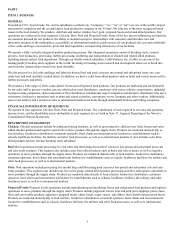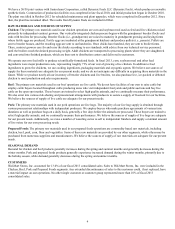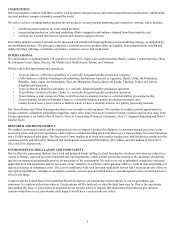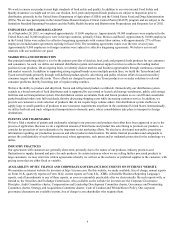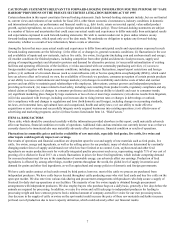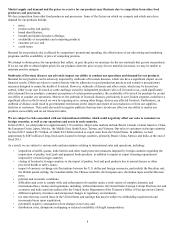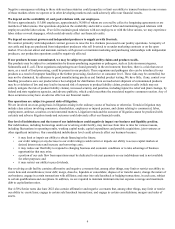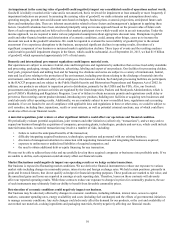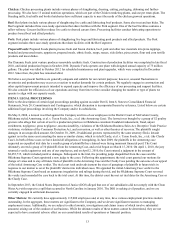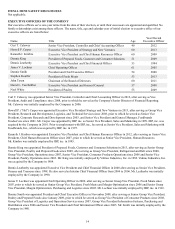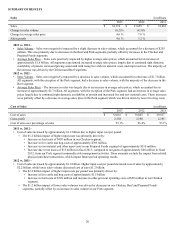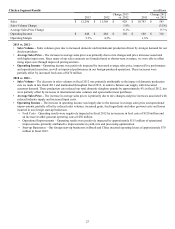Tyson Foods 2013 Annual Report Download - page 13
Download and view the complete annual report
Please find page 13 of the 2013 Tyson Foods annual report below. You can navigate through the pages in the report by either clicking on the pages listed below, or by using the keyword search tool below to find specific information within the annual report.13
Chicken: Chicken processing plants include various phases of slaughtering, dressing, cutting, packaging, deboning and further-
processing. We also have 15 animal nutrition operations, which are part of the Chicken rendering plants, and one pet treats plant. The
blending mills, feed mills and broiler hatcheries have sufficient capacity to meet the needs of the chicken growout operations.
Beef: Beef plants include various phases of slaughtering live cattle and fabricating beef products. Some also treat and tan hides. The
Beef segment includes three case-ready operations that share facilities with the Pork segment. One of the beef facilities contains a
tallow refinery. Carcass facilities reduce live cattle to dressed carcass form. Processing facilities conduct fabricating operations to
produce boxed beef and allied products.
Pork: Pork plants include various phases of slaughtering live hogs and fabricating pork products and allied products. The Pork
segment includes three case-ready operations that share facilities with the Beef segment.
Prepared Foods: Prepared Foods plants process fresh and frozen chicken, beef, pork and other raw materials into pizza toppings,
branded and processed meats, appetizers, prepared meals, ethnic foods, soups, sauces, side dishes, pizza crusts, flour and corn tortilla
products and meat dishes.
Our Dynamic Fuels joint venture produces renewable synthetic fuels. Construction of production facilities was completed in late fiscal
2010, and initial production began in October 2010. Dynamic Fuels operates one plant with designed annual capacity of 75 million
gallons. The plant was idled in October 2012 for scheduled maintenance and plant upgrades, which were completed in December
2012. Since then, the plant has remained idled.
We believe our present facilities are generally adequate and suitable for our current purposes; however, seasonal fluctuations in
inventories and production may occur as a reaction to market demands for certain products. We regularly engage in construction and
other capital improvement projects intended to expand capacity and improve the efficiency of our processing and support facilities.
We also consider the efficiencies of our operations and may from time to time consider changing the number or type of plants we
operate to align with our capacity needs.
ITEM 3. LEGAL PROCEEDINGS
Refer to the description of certain legal proceedings pending against us under Part II, Item 8, Notes to Consolidated Financial
Statements, Note 20: Commitments and Contingencies, which discussion is incorporated herein by reference. Listed below are certain
additional legal proceedings involving the Company and/or its subsidiaries.
On May 8, 2008, a lawsuit was filed against the Company and two of our employees in the District Court of McCurtain County,
Oklahoma styled Armstrong, et al. v. Tyson Foods, Inc., et al. (the Armstrong Case). The lawsuit was brought by a group of 52 poultry
growers who allege that certain of our live production practices in Oklahoma constitute fraudulent inducement, fraud, unjust
enrichment, negligence, gross negligence, unconscionability, violations of the Oklahoma Business Sales Act, Deceptive Trade Practice
violations, violations of the Consumer Protection Act, and conversion, as well as other theories of recovery. The plaintiffs sought
damages in an unspecified amount. On October 30, 2009, 20 additional growers represented by the same attorney filed a lawsuit
against us in the same court asserting the same or similar claims, which is styled Clardy, et al. v. Tyson Foods, Inc., et al. (the Clardy
Case). In both of these cases we have denied all allegations of wrongdoing. In June 2009, the plaintiffs in the Armstrong case
requested an expedited trial date for a smaller group of plaintiffs they claimed were facing imminent financial peril. The Court
ultimately severed a group of 10 plaintiffs from the Armstrong Case, and a trial began on March 15, 2010. On April 1, 2010, the jury
returned a verdict against us and one of our employees, and on April 2, 2010, the Court entered a judgment in the amount of
$8,655,735, which included punitive damages. Subsequent to the trial, the presiding judge disqualified from the cases and the
Oklahoma Supreme Court appointed a new judge to the cases. Following this appointment, the trial court granted our motions for
change of venue and to stay all future trials of plaintiffs in the Armstrong Case and the Clardy Case pending the outcome of our appeal
of the initial Armstrong Case verdict. The trial court took under advisement the sizes of groupings of plaintiffs in future trials in
response to our motion to sever the plaintiffs' claims into individual cases. We appealed the initial Armstrong Case verdict to the
Oklahoma Supreme Court based on numerous irregularities and rulings during the trial, and the Oklahoma Supreme Court reversed
the verdict and remanded the case back to the trial court. At this time, the district court has not set trial dates for the Armstrong Case or
the Clardy Case.
In September 2013, the United States Department of Justice (DOJ) alleged that one of our subsidiaries did not comply with the Clean
Water Act with respect to a spill that occurred in North Carolina in January 2010. The DOJ is seeking civil penalties, and we are
currently engaged in settlement discussions.
Other Matters: We currently have approximately 115,000 employees and, at any time, have various employment practices matters
outstanding. In the aggregate, these matters are significant to the Company, and we devote significant resources to managing
employment issues. Additionally, we are subject to other lawsuits, investigations and claims (some of which involve substantial
amounts) arising out of the conduct of our business. While the ultimate results of these matters cannot be determined, they are not
expected to have a material adverse effect on our consolidated results of operations or financial position.


